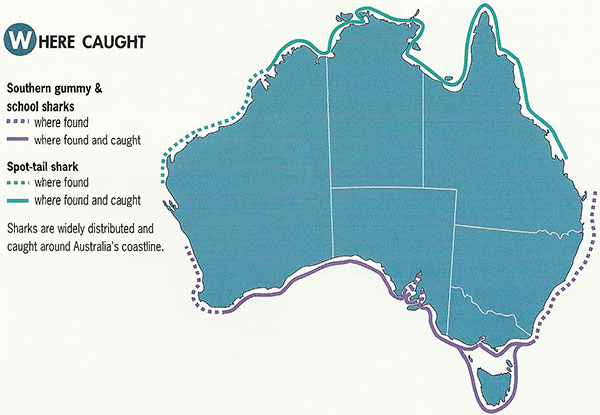School sharks used to be targeted however given their current status of ‘overfished’, school sharks are only taken as a bycatch while targeting gummy shark.
Catch limits
| Catch limit | Fishing Mortality* | Biomass** |
|---|---|---|
Catch Limit (Incidental) 207 tonnes For the 2025–26 Season | R;Subject to overfishing | R;Overfished |
* Fishing mortality status relates to the level of fishing pressure on a stock - specifically, whether fishing mortality in the year being assessed is likely to result in the stock becoming overfished, or prevent the stock from rebuilding from an overfished state. If fishing mortality exceeds either of these thresholds, a stock is considered to be subject to overfishing.
** Biomass status relates to how many fish there are - specifically, whether the biomass in the year being assessed is above the level at which the risk to the stock is considered to be unacceptable. The HSP defines this level as the limit reference point, below which the stock is considered to be overfished.
Scientific name: Galeorhinus galeus
Family: Triakidae
Other names: Snapper shark, eastern school shark, soupfin shark, tope
Description: School sharks have slender bodies with grey or brown backs and upper sides, and white bellies. The snout is long and the underside near the tip is often translucent. The second dorsal fin is smaller than the first.
Size (length and weight): Up to 1.8 metres in length and 37 kg. Females grow larger than males.
Life span: Up to 60 years.
Habitat: School shark are a temperate demersal species found on the continental shelf and slope. They can be found to depths of 550 metres, and often move up into the water column at night. School shark segregate into schools according to size and sex. Size generally increases from inshore to offshore. Pups and juveniles aggregate in shallower ‘nursery’ waters during the spring and summer. School shark undertake long migrations of up to 1400 km along the southern coast of Australia, which are thought to be associated with homing to natal mating and pupping grounds.
Prey: Fish, squid, octopus and benthic invertebrates.
Predators: Larger sharks.
Reproduction: School shark reach reproductive maturity at 8-15 years of age (about 8 years for males and at least 10 years for females). Females are ovoviviparous and produce pups every 2‑3 years. Litter sizes range from 15‑43 pups. Birth occurs in early summer after a gestation period of 12 months. Pups are born in shallow bays and estuaries.
Other: School shark are classified as Vulnerable by the IUCN Red List of Threatened Species. They are listed as Conservation Dependent under the EPBC Act and are managed under AFMA’s School Shark Rebuilding Strategy.
| Fishery found in | Gear used | Catch of this species is targeted or incidental |
|---|---|---|
| Southern and Eastern Scalefish and Shark Fishery – Gillnet Hook and Trap Sector | Gillnet, longline | Incidental |
| Southern and Eastern Scalefish and Shark Fishery – Commonwealth Trawl Sector | Bottom trawl | Incidental |
| State managed fisheries – Tasmania, Victoria, South Australia | Bottom trawl, gillnet, longline | Incidental |
School sharks are managed under an incidental catch limit, which allows a set amount of school shark to be landed which has been incidentally taken by fishers while targeting gummy shark.
School sharks are distributed around southern Australia mainly on the continental shelf and upper slope where they have been recorded from Moreton Bay (southern Queensland) to Perth (Western Australia), including Tasmania. They have been taken from the nearshore zone to 550 metres depth, mainly near the bottom, but sometimes move through the water column further away from the shore.

School shark can be caught by fishers using trawl nets, gillnets and longlines to fish for gummy shark.
Sometimes, bottom trawling can catch unwanted species of fish (not the type of fish the net was supposed to catch). This is known as bycatch and it is monitored by on-board fishery observers who assess the environmental impact of the trawling.
Although it is not physically possible to trawl on reef structures, significant long-term damage can occur if sensitive habitat areas like corals, sponges and seagrass beds are trawled. To ensure these sensitive habitat areas are protected from trawling, management arrangements such as area closures are extensively used.
AFMA’s management of commercial trawl fisheries aims to ensure trawl fishing has the least impact possible on the environment.
Gillnets have a minimal impact on the seafloor as they are stationary when set. Gillnets have the potential to interact with marine mammals, although when set properly, larger predatory sharks and marine mammals will bounce off the firm netting.
Bottom longline fishing causes very little damage to the sea floor and has only a very limited level of bycatch. Gear can become snagged on the bottom and get broken off, although this is not a common occurrence. Fish which have been caught are brought to the surface slowly, and are often alive when they reach the boat, which greatly increases their chance of survival when returned to the water.
Gear
Want to know more?
This is just an overview of school shark, if you want to know more see the links below.
This fish is managed under the Southern and Eastern Scalefish and Shark Fishery.